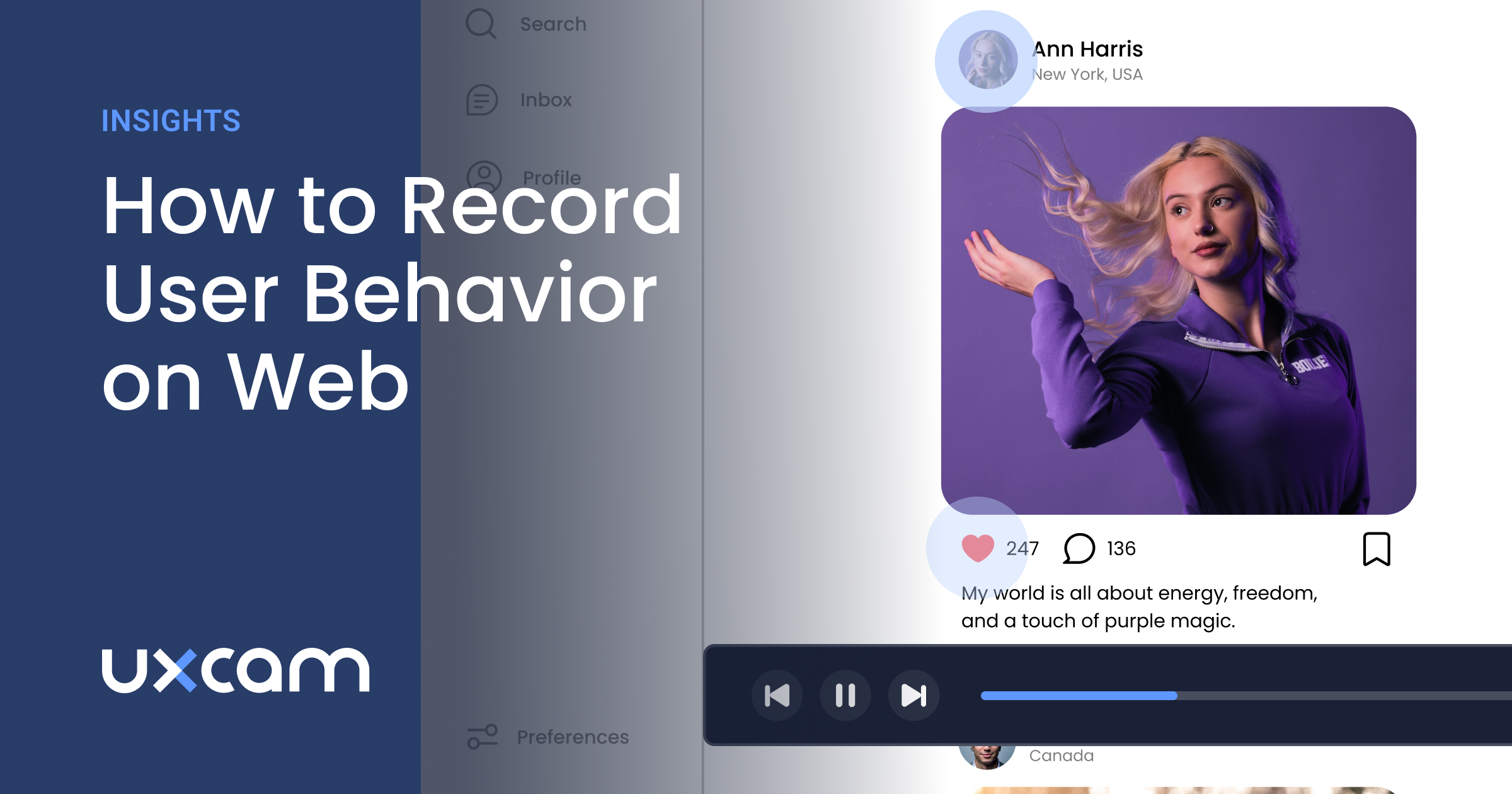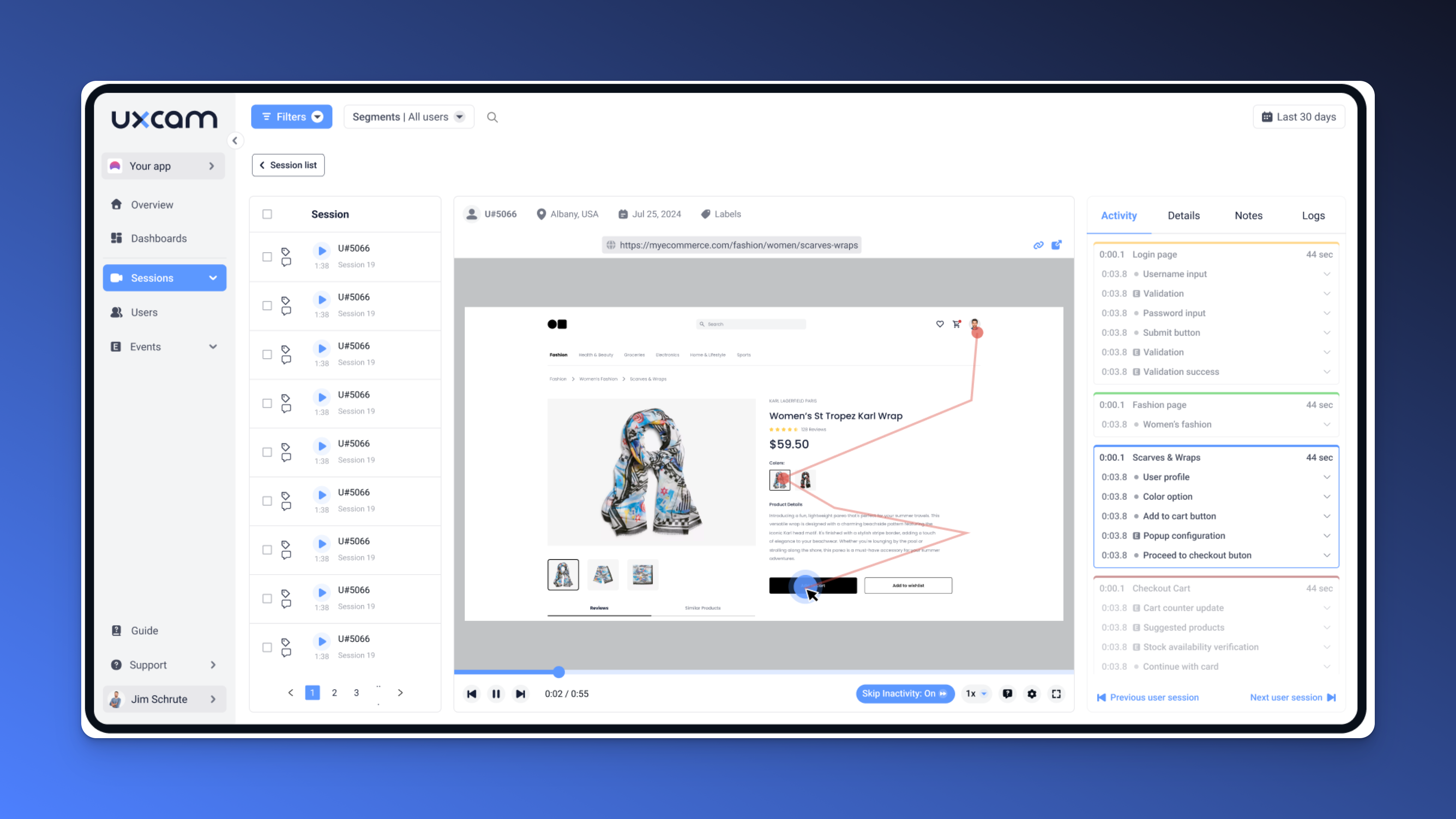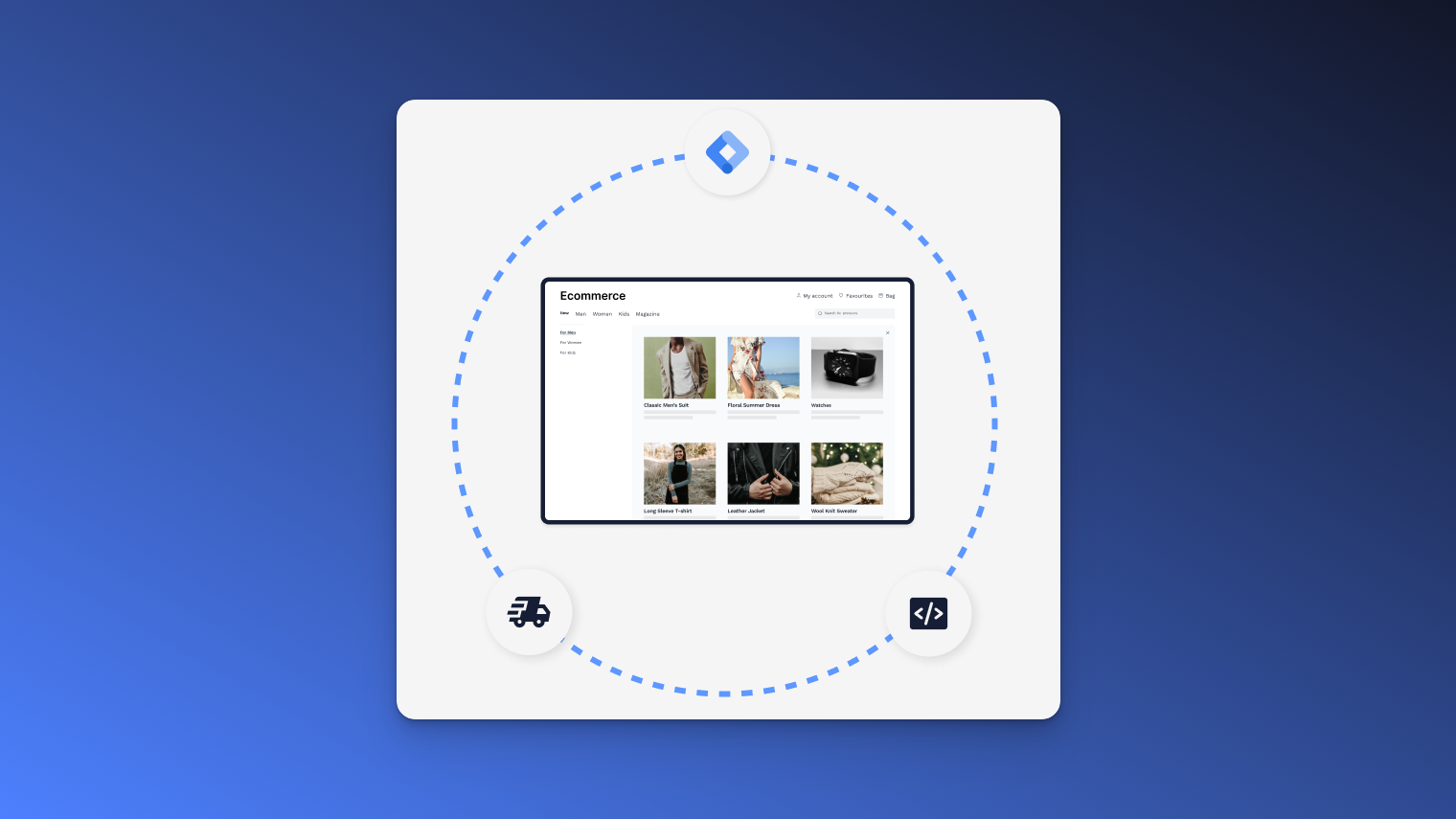Back to blog
16 MIN READ
How to Record User Behavior on Websites (and Why It Matters)
PUBLISHED
8 February, 2025

Product Analytics Expert

Understanding how users interact with your website or web app is crucial for success. In today's competitive digital landscape, recording user behavior provides insights that can make or break your product. In fact, research shows that organizations leveraging customer behavior data massively outperform their peers – they see 85% higher sales growth and over 25% more gross margin on average (mckinsey.com).
Why such a difference? Because knowing what users do, where they click, and where they get frustrated helps you fix issues, enhance user experience, and ultimately boost your bottom line.
This article explores the importance of tracking user behavior on web applications, backed by statistics and real examples. We’ll also look at the benefits (from UX improvements to conversion optimization and debugging), and highlight UXCam as a top tool to record user interactions. A step-by-step guide is included on how to integrate UXCam into your web app using Google Tag Manager, along with best practices to do it ethically and in compliance with privacy laws. Let’s dive in.
Why Recording User Behavior is Important for Web Apps


Every click, tap, scroll, or hesitation by a user tells a story about their experience. If you aren't listening to that story, you’re essentially flying blind. Here are a few reasons why recording user behavior is so important:
Identify UX Issues: User behavior tracking reveals what’s working and what isn’t on your app. It shows where users get stuck or drop off. For example, if 30% of users abandon a signup flow, watching session recordings might uncover a confusing form or a broken button causing the frustration.
Data-Driven Improvements: Rather than guessing what users want or how they behave, you base decisions on real data. Companies that make use of behavioral insights can dramatically outperform those that don’t.
User Expectations are High: Today’s users expect smooth, intuitive experiences. 88% of users are less likely to return to a site after a bad user experience In other words, if your web app frustrates people, you may lose the majority of them for good. Tracking behavior helps you catch those frustration points and address them before they drive users away.
Widespread Adoption of Analytics: Most successful businesses already track user behavior in some form, underscoring its importance. Nearly half of all websites use Google Analytics (giving Google ~82% of the web analytics market share according to w3techs.com). If your team isn’t tracking user interactions yet, chances are your competitors are – and they’re using that information to improve their products continuously.
Using UXCam to Record User Behavior on Web Apps


There are many tools available for tracking user behavior, but UXCam stands out as a top choice, especially for web and mobile apps. UXCam is an all-in-one analytics solution that focuses on user experience. It combines automatic event capture, advanced analytics, and session replay in one platform.
This means you don't need to stitch together separate tools for heatmaps, event tracking, and session recordings – UXCam handles it all, saving time and simplifying your stack.
Key features and advantages of UXCam include:
Session Replay with Deep Analytics: UXCam records user sessions (essentially video-like replays of user interactions) and links them directly with analytics data. This is extremely powerful – for example, if you notice a drop-off in a conversion funnel, you can instantly jump to the actual session replays of users who dropped off at that step. This tight integration of quantitative and qualitative data helps you quickly uncoverwhy users are behaving a certain way. It goes beyond basic replay by letting you filter and search sessions by events, user properties, rage clicks, errors, and more.
Autocapture (Tagless Tracking): UXCam can automatically capture all relevant user interactions without requiring you to manually tag every button or event. Every click, tap, swipe, and screen transition can be recorded out-of-the-box. This tagless autocapture means you start gathering data immediately, and you won’t miss important events because someone forgot to instrument them. It eliminates complex setup and delivers value in weeks, not months.
Heatmaps & Interaction Analytics: In addition to session videos, UXCam provides heatmaps for clicks, taps, and scrolls. This shows aggregate behavior trends (like which parts of a page get the most attention). You can see, for instance, that users tend to click a certain icon often (indicating high interest), or that hardly anyone scrolls to the bottom of a page (indicating low engagement with the content there). These insights complement session replays by giving you the big-picture patterns.
Funnel and Cohort Analysis: UXCam’s built-in analytics allow you to set up funnels (to see conversion rates between steps) and segment users by properties or behavior. You might segment by new vs. returning users, or by users who completed onboarding vs. those who didn’t, to compare their behaviors. This helps target UX improvements to specific user groups. And because UXCam ties these analytics to session replays, you can dig into why a certain segment behaves differently.
Easy Integration & Wide Compatibility: UXCam supports web apps (including single-page applications) as well as native mobile apps. For web, it can be added via a simple JavaScript snippet or through Google Tag Manager (as we’ll explain next). It also offers integrations with popular tools like Google Analytics, Amplitude, Mixpanel, and others, so you can augment your existing data. Despite its rich capabilities, developers find it straightforward to implement. For instance, you can deploy UXCam on a website in minutes via GTM, and start seeing user session data right away.
Privacy and Security Features: Understanding that user recordings can raise privacy concerns, UXCam provides options to mask sensitive data (like password fields or personal info) and comply with regulations. This ensures you can record behavior while still protecting user privacy.
With these features, UXCam has become a go-to solution for many product teams looking to improve their web apps. It’s used by companies around the world to iterate on designs, squash usability bugs, and optimize conversions. Now, let's look at how you can get UXCam up and running on your own web app.
How to Integrate UXCam with Google Tag Manager (Step-by-Step)


One convenient way to add UXCam to your web application is by using Google Tag Manager (GTM). GTM allows you to inject tracking scripts into your site without manual code changes to your pages. UXCam’s official documentation provides a clear guide on how to set this up (developer.uxcam.com). Follow these steps to start recording user behavior with UXCam via GTM:
Add Google Tag Manager to Your Site: If you haven’t already, begin by adding the GTM container snippet to all pages of your web app. Google Tag Manager will provide you with a code snippet (JavaScript) when you set up an account. Include that script in the <head> (and <body> as instructed) of your website’s HTML, so GTM can manage tags on those pages. (If your site already uses GTM, you can skip this step.)
Create a UXCam Tag in GTM: Log in to your Google Tag Manager workspace for your site and click on “Tags” -> “New”. Choose Tag Type: Custom HTML. This lets you add a custom script. Now paste the UXCam JavaScript snippet into the HTML field. The snippet is provided by UXCam – it looks like a block of code that initializes window.uxc and loads the UXCam recording script from websdk-recording.uxcam.com (you can find this in your UXCam dashboard or documentation). In that snippet, be sure to replace 'yourAppKey' with the actual App Key of your UXCam account. This app key ties the recordings to your project in UXCam’s backend.
Configure the Trigger: Still in the GTM tag setup, you need to set a trigger so that this UXCam script runs on all relevant pages. Choose Trigger: Page View – All Pages. This ensures that every time any page on your web app loads, the UXCam tracking script will execute. (If you only want to record certain pages or users, you could adjust the trigger conditions, but typically All Pages is used to get a comprehensive view of user behavior across the site.)
Save and Publish: After adding the UXCam script and setting the trigger, save your new tag. Then click “Submit” in GTM to publish your container changes. Once published, the UXCam script will be live on your site, and you should begin capturing user sessions. You can verify it's working by using GTM’s Preview mode or by checking your UXCam dashboard for incoming session data.
(Optional) Track Custom Events: UXCam’s default autocapture will record a lot of interactions automatically. However, you might want to send additional custom events (for example, when a user completes a specific action like clicking a special button or reaching a milestone in your app). You can do this via GTM as well. The process is similar: create a new Custom HTML tag for each custom event you want to track. In the HTML, you can call the uxc.event() function provided by UXCam. For instance: <script>uxc.event("SignedUp", { plan: "Pro" });</script> would log a "SignedUp" event with a property indicating the plan type. Set triggers for these tags as appropriate (e.g., a Click trigger on the sign-up button, or a Form Submission trigger) Then publish the container. Now UXCam will receive those custom events in addition to the auto-captured data. (Be sure to test in GTM Preview mode to ensure the events fire correctly.)
That’s it! With those steps, UXCam should be successfully integrated via GTM. The official UXCam documentation on GTM integration provides additional details and screenshots if you need more help.
Once set up, you can log into UXCam’s dashboard to watch session replays, view heatmaps, and analyze the wealth of user behavior data coming from your web app.
Real-World Examples of Behavior Tracking Success
To really understand the impact of recording user behavior, let's look at some real-world case studies and examples. These highlight how businesses have benefited from tracking users on their apps:
Costa Coffee – The Costa Coffee team discovered via UXCam analytics that about 15% of new users dropped off during registration due to invalid password entries. By fixing the password requirements and guidance, they increased app sign-ups by 15% for their loyalty program. This is a direct example of finding a UX issue through user behavior data and immediately boosting conversions as a result.
Recora – Recora used session replay to investigate why they were getting many support tickets about their app. Replays revealed several pain points and usability issues that were frustrating users. Armed with this information, Recora’s team made targeted UX improvements and bug fixes. The outcome was a 142% reduction in support tickets (users were no longer encountering those confusing issues). In essence, user behavior tracking not only improved UX but also saved support costs and improved customer satisfaction.
PlaceMakers – This company doubled their in-app sales by leveraging behavior analytics. They identified a major friction point in the purchase flow via session recordings – users were getting stuck due to a UX flaw during a supply chain shortage scenario. By resolving that issue, PlaceMakers removed the barrier to purchase, resulting in a 2x increase in sales through the app.
These examples underline a common theme: when you listen to your users (through their actions), you can make impactful changes. Whether it's increasing conversion rates, boosting user retention, driving more sales, or reducing support load, the insights gained from behavior tracking translate into real business value.
Statistics and Research Supporting User Behavior Tracking
Concrete data and research strongly support the need to record and analyze user behavior on websites and web apps. Consider these telling statistics:
ROI of UX Improvements: Investing in user experience yields huge returns. Simply boosting your UX budget by 10% can lead to an 83% increase in conversion rates. Better usability directly translates to more sign-ups, purchases, or whatever conversion your app targets.
Retention and Satisfaction: A good user experience keeps customers coming back, while a bad one drives them away. We already noted that 88% won’t return after a bad experience. Likewise, PwC found 32% of customers will leave a brand they love after just a single negative experience. Tracking user behavior can alert you to those negative experiences (e.g. frustrating errors or confusing UI flows) so you can address them before they impact a large share of users.
Abandonment Issues: On mobile, about 21% of users abandon an app after just one use. Often, this is because the first experience didn’t impress or something didn’t work right. By analyzing user sessions, you can discover why users aren’t coming back — maybe the app crashed, or the onboarding was unclear — and fix it to improve retention.
Industry Trend: More organizations are recognizing the value of behavior analytics. McKinsey notes that using customer behavioral data isn’t just a tech gimmick but a strategic advantage, as highlighted by the outsized performance of companies that harness these insights. In short, tracking user behavior has moved from “nice-to-have” to “must-have” for data-driven product teams.
These statistics make it clear: ignoring user behavior is a missed opportunity, and potentially a costly one. Now let's look at what you stand to gain by doing it.
Benefits of Tracking User Behavior on Web Apps
Recording and analyzing user behavior can positively impact many areas of your web app and business. Here are some of the key benefits:
1. Improved User Experience (UX)
Watching real users interact with your app is one of the fastest ways to uncover UX issues. Session recordings, heatmaps, and click analytics reveal where users struggle, get confused, or drop off. With this knowledge, you can streamline those rough spots. For example, if recordings show users repeatedly clicking a non-clickable element (so-called "rage clicks"), you might need to make that element interactive or clarify the UI. If scroll tracking shows users never reach important content, you might move that content higher on the page.
By addressing the pain points identified through behavior tracking, you create a smoother, more intuitive experience. This leads to happier users who are more likely to stick around. In the end, a better UX isn’t just good for users – it’s good for business. Satisfied users are far more likely to become repeat customers and even evangelize your app to others. On the flip side, identifying a single UX problem and fixing it can yield huge gains (as we’ll see in the case studies). In summary, user behavior data takes the guesswork out of UX design, letting you base improvements on real evidence of what users need.
2. Higher Conversion Rates and Engagement
User behavior tracking is a cornerstone of conversion rate optimization (CRO). It helps you answer critical questions like: Where in the funnel do users drop off? Which features or pages get the most engagement? Are users following the path you expect or are they getting sidetracked?
By analyzing these patterns, you can optimize the user journey to increase conversions. For instance, you might discover via recordings that many users abandon their shopping cart on a particular step of checkout. Further investigation might reveal a form validation error or a confusing UI element on that step. Fixing it could immediately reduce cart abandonment and boost completed purchases. In fact, many companies have seen significant conversion lifts by acting on user behavior insights. Costa Coffee, for example, found that 15% of new users dropped off due to invalid password errors during sign-up; after fixing this UX issue, registrations jumped by an equivalent 15%.
Moreover, tracking user behavior can highlight opportunities to improve engagement. If you notice users often hover on a feature without clicking (perhaps unsure what it does), adding a tooltip or improving the call-to-action can increase interaction. For content-driven sites, seeing where users scroll or which sections they skip can guide you in rearranging content for better engagement. Overall, you can’t improve what you don’t measure – by measuring user actions, you open the door to iterative optimizations that drive higher conversion and engagement metrics.
3. Faster Debugging and Issue Resolution
When something goes wrong on your web app, user behavior logs and session replays are invaluable for debugging. Rather than relying on sparse bug reports or trying to reproduce an issue blindly, you can replay exactly what the user did leading up to an error or crash. This makes it much easier for developers to identify the root cause. It’s like having a CCTV camera for your app: you can see the sequence of events and UI states that led to a problem.
Many businesses have used session recordings to dramatically improve their support and development process. For example, Recora cut down support tickets by 142% after using session replay to understand UX issues causing user confusion.
By watching recordings of troublesome sessions, their team could fix glitches and improve the interface, which in turn meant fewer users contacting support for help. Similarly, if users are clicking a button and nothing happens due to a JavaScript error, you’ll see that in the replay and can prioritize fixing that bug immediately.
In short, tracking user behavior doesn’t just help product managers and designers — it’s a boon for your QA and engineering teams as well. It leads to faster identification of issues, quicker fixes, and a more stable, user-friendly application.
Best Practices for Ethical and Compliant User Behavior Tracking
While the benefits of recording user behavior are clear, it's equally important to do it in an ethical and privacy-conscious way. Users deserve respect and transparency regarding any data collected about them. Here are some best practices to ensure your user behavior tracking remains ethical and compliant:
Transparency and Consent: Always inform users that you’re collecting usage data. The best practice is to include this in your privacy policy and, where applicable, use a cookie consent banner or opt-in mechanism for tracking. Users should know that session recording or analytics are in operation and why (e.g. to improve the product). In some jurisdictions (like the EU under GDPR), you may be legally required to obtain explicit consent before recording sessions. Being upfront builds trust. Remember, users must be informed about session replay software and its purpose, and ideally give consent (opsmatters.com).
Anonymize and Mask Sensitive Data: Never record sensitive personally identifiable information (PII) through your session recordings. This means ensuring that things like passwords, credit card numbers, personal details, etc., are masked or excluded. Many tracking tools (including UXCam) offer features to automatically occlude sensitive data on the client side. Use these features! For example, you might configure UXCam to not record keystrokes in certain input fields or to blur out sections of the screen that could contain private info. This way, even if you replay a session, you won’t see things like a user’s password or payment details. Anonymization of user identities (unless you need to tie a session to a specific user for support) is also recommended. In short, capture the behavior but not the personal data. This protects user privacy and keeps you compliant with regulations.
Data Security: Treat user behavior data with care. Even if you've masked PII, session replays can still be sensitive. Ensure that the analytics tool you use transmits and stores data securely (HTTPS, encryption at rest, etc.). Control who in your organization can access replays – for instance, limit it to the product team and engineers who need it, and have them trained on privacy. Protect the data from unauthorized access or breaches. Users are entrusting you with their interactions; it’s your responsibility to safeguard that information.
Purpose Limitation: Use the data only for its intended purpose – improving your website/app. Session recordings should be a tool to enhance UX, debug, and boost conversions, not a way to spy on users for the sake of curiosity. Define clear guidelines internally for how the team uses behavior data. For example, prohibit using session replays to snoop on individual users’ personal usage or to do anything nefarious. By keeping a strict focus on UX improvement, you ensure ethical use of the data.
Data Minimization and Retention: Collect only the data you actually need. It might be tempting to record everything forever "just in case," but that increases risk. Instead, decide on a sensible data retention policy for user recordings. Many companies, for instance, only keep session data for a few weeks or months, enough to analyze and act on, but not forever. Regularly purge old recordings that are no longer necessary. This not only mitigates privacy concerns but can also save on storage costs and reduce clutter in your analysis tools. Also, if your analytics tool allows it, consider sampling (recording, say, a percentage of sessions rather than all users) if that achieves your goals – this minimizes data collected.
Respect User Rights: Users may have rights under laws like GDPR or CCPA to request access to their data or ask for it to be deleted. Be prepared to honor such requests. Even outside of legal requirements, it's good practice to allow users an option to opt out of tracking. For example, you could honor "Do Not Track" signals or provide a toggle in account settings that stops session recording for that user. Additionally, if a user reaches out with concerns, be transparent about what data you have from their sessions. Providing users with control over their data goes a long way in maintaining trust.
By following these best practices, you can gain all the benefits of user behavior tracking while respecting your users’ privacy and maintaining their trust. Ethical tracking is not just about avoiding legal trouble; it's about building a better relationship with your users. When users feel respected, they're more likely to remain loyal and engaged.
Conclusion
Recording user behavior on your website or web app is a powerful technique to gather actionable insights. It shines a light on the user’s journey – revealing what delights them, where they hesitate, and what frustrates them. As we've discussed, leveraging these insights can lead to significant improvements: a smoother user experience, higher conversion rates, more engaged customers, and faster resolution of issues. Companies big and small have reaped these rewards, from boosting signup rates by double digits to cutting support loads in half, simply by paying attention to user behavior.
Tools like UXCam make it easier than ever to start tracking and learning from your users’ actions. With features like session replay, heatmaps, and automatic event capture, you can get a complete picture of how people experience your web app. The integration is straightforward (especially using Google Tag Manager as outlined above), so you can start gathering data without a heavy development lift. The key is to act on those insights – use them to drive UX improvements, A/B test changes, fix bugs, and iterate toward a better product.
Finally, as you implement user behavior tracking, do so thoughtfully. Respect user privacy, be transparent, and use the data responsibly. When done right, it's a win-win: users get a better product tailored to their needs, and you get better results for your business. In an era where user experience is often the differentiator between you and the competition, recording and analyzing user behavior on your web app is not just beneficial – it’s essential. Start listening to your users’ actions today, and let those insights guide you to a more successful, user-centric web app tomorrow.
AUTHOR

Jonas Kurzweg
Product Analytics Expert
What’s UXCam?
Related articles
Website Analysis
What is Web Analytics? Definition, Metrics & Best Practices
Discover what web analytics is, its definition, key examples, and the best tools to optimize your website's performance and user...

Tope Longe
Product Analytics Expert
Website Analysis
Website Heatmap - Ultimate Guide and Best Tools [2026]
Read the ultimate 2026 guide to website heatmaps: discover types, implementation, and the best heatmap tools to optimize user experience and site's...

Jonas Kurzweg
Product Analytics Expert
Website Analysis
Website Analysis - The Ultimate Guide 2025
Website analysis guide: Discover actionable tips to analyze and optimize your site for peak efficiency and user satisfaction. Ready to elevate your web...

Jonas Kurzweg
Product Analytics Expert
